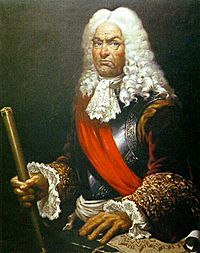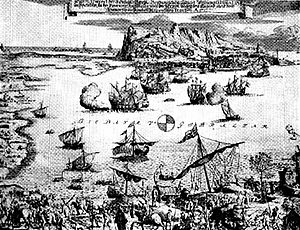Thirteenth siege of Gibraltar facts for kids
Quick facts for kids Thirteenth siege of Gibraltar |
|||||||
|---|---|---|---|---|---|---|---|
| Part of the Anglo-Spanish War (1727–1729) | |||||||
 Die Baya v Gibraltar, unknown author |
|||||||
|
|||||||
| Belligerents | |||||||
| Commanders and leaders | |||||||
| Strength | |||||||
| 5,500 | 17,500 | ||||||
| Casualties and losses | |||||||
| 118 killed 207 wounded |
392 killed 1,019 wounded |
||||||
The siege of Gibraltar of 1727 was a major event during the Anglo-Spanish War (1727–1729). It was the thirteenth time Gibraltar had been attacked, and the second time Spain tried to take it back from Britain.
Spanish forces had between 12,000 and 25,000 soldiers. The British defenders started with about 1,500 men. This number grew to around 5,000 during the siege. After five months of fighting, with many failed attacks, the Spanish troops gave up. They pulled back their forces. This failure helped bring the war to an end. It led to the Treaty of El Pardo in 1728 and the Treaty of Seville in 1729.
Contents
Why Did Spain Attack Gibraltar?
On January 1, 1727, the Spanish ambassador sent a letter to the British government. He explained why Spain believed they should get Gibraltar back.
Spain argued that Britain had broken the rules of the Treaty of Utrecht. This treaty had given Britain control of Gibraltar. Spain said Britain had built new forts outside the agreed-upon borders. They also claimed Britain allowed Jews and Moors to live there. This was against the treaty's rules. Spain also mentioned smuggling that hurt their economy. This letter was almost like a declaration of war.
Spain's Challenges in Attacking Gibraltar
Spain was not in a strong position to capture Gibraltar in 1727. In their last attempt in 1704, Spain had a powerful navy. They also had help from French warships. But after losing battles like Battle of Cape Passaro, Spain's navy was much weaker.
The British Royal Navy controlled the sea around Gibraltar. This meant Spain could not land troops from the south. It also made sure the British defenders could get supplies easily. Any attempt to climb the Rock from the east was also impossible. The British had destroyed the old path.
So, Spain's only way to attack was from the north. This was a narrow strip of land between the sea and the Rock. This area was dangerous for attackers. It was open to fire from three sides: Willis's battery, the Grand Battery, and the Devil's Tongue Battery.
Disagreement Among Spanish Leaders
Some of King Philip V's top military advisors warned him. They said taking Gibraltar would be almost impossible without naval support. The Marquis of Villadarias, who led the 1704 attack, agreed. George Prosper Verboom, a senior engineer, also thought a sea attack was the only way to succeed.
However, King Philip V was impressed by the Count de las Torres de Alcorrín. The Count promised he could "deliver Spain from this noxious settlement" in six weeks. This disagreement continued throughout the siege. A British diarist even wrote that a Spanish deserter reported a fight between two generals.
Who Fought in the Siege?
Despite Verboom's doubts, the King let de las Torres try to capture Gibraltar. The Count gathered his troops near San Roque in early 1727. He had 30 infantry battalions, 6 horse squadrons, 72 mortars, and 92 guns. Some heavier guns were brought from Cadiz.
Many of the Spanish army's soldiers were not Spanish. 19 of the 30 infantry battalions were foreign soldiers. These included Walloons, French Belgians, Irish, Savoyards, Neapolitans, Swiss, Corsicans, and Sicilians.
British Defenders and Reinforcements
The Governor of Gibraltar, the Earl of Portmore, was in England. So was the Lieutenant Governor, Brigadier Jasper Clayton. Colonel Richard Kane was in charge of the British forces. He had about 1,200 men. These men were from the 5th, 13th, 20th, and 30th Regiments.
Kane sent away the 400 Spanish residents of Gibraltar. He also worked to improve the defenses. On February 13, Brigadier Clayton arrived with more troops. These were from the 26th, 29th, and 39th Regiments. Admiral Sir Charles Wager also arrived with his fleet.
By early February, Spanish workers began building trenches near Gibraltar. On February 22, the British fired a warning shot. An hour later, they began to fire cannons at the Spanish workers. This marked the start of the thirteenth siege.
The Siege of Gibraltar Begins
The Count de las Torres's first plan was to move five battalions and 1,000 workers forward at night. They took over the Devil's Tower and two other old forts. They also dug trenches close to Gibraltar's walls.
British cannons could not aim low enough to hit the workers directly. The trenches would have given the Spanish a good place to attack the town. However, Admiral Wager moved his ships. He positioned them to fire on the Spanish workers from the side. For three days, his ships fired on them. This caused over 1,000 casualties for the Spanish.
The Spanish quickly built batteries to try and push Wager's ships away. But even without the ships, strong winds and heavy rain made digging trenches very hard.
Challenges for the Spanish Attackers
Willis's battery, on the North Face of the Rock, caused many problems for the Spanish. The Spanish found a cave under the Rock. They planned to dig a tunnel and fill it with gunpowder. They hoped to blow up Willis's Battery.
The British defenders noticed this activity. They were worried. One account says the British tried to dig a mine over the Spanish. Another says they invented a machine to lower a man down the Rock to spy. However, the rock under Willis's battery was too hard to mine quickly. It would have taken many months.
First Major Bombardment
Since a land attack was difficult and a sea attack was impossible, de las Torres decided to bombard the British. On March 24, the Spanish began a heavy cannon attack. They hoped this would force the British to surrender.
One person wrote that from this point, it was a "gunner's war." The British could only receive the enemy's fire and shoot back. The Spanish caused a lot of damage to the northern part of the town. Many houses were destroyed. After the siege, these ruins were cleared to create the area known as Casemates.
Despite the damage, there were few British deaths. The main concern was having enough men to fire the guns, fix the forts, and stand guard. This was a big challenge for the British.
The Spanish bombardment lasted for ten days. Bad weather, with heavy rains and wind, made things difficult for the Spanish in their trenches. They had to slow down their attack. A Spanish journal from Madrid described their problems. It said many soldiers were leaving or getting sick. New troops were needed from Malaga. The journal also noted that the British had not lost many men.
British Reinforcements Arrive
During a break in the Spanish attack, the British received much-needed help. On April 7, the 25th and 34th Regiments arrived. They brought 480 men from Menorca. Then, on May 1, the Governor, the Earl of Portmore, arrived. He brought ten companies of the Grenadier Guards and the 14th Regiment.
To make space for the new troops, some regiments moved south. They set up tents near Europa Point. This area is now called Camp Bay because soldiers camped there during this siege. In 1727, many trees on the Rock were cut down for firewood by the soldiers.
One of the few British attacks happened just before Lord Portmore arrived. It was a clever plan, but it failed because the gunners fired too early.
Second Major Bombardment
By May 7, de las Torres was ready for another heavy bombardment. This attack caused major damage to the town and forts. It also led to more British casualties than any other time in the siege.
However, the new British soldiers helped a lot. They allowed the defenders to keep firing their guns and repair the damage. Lord Portmore increased the soldiers' pay to boost their spirits.
The Spanish guns began to fire less often. After many days of continuous firing, their iron cannons started to break. Their brass cannons became too hot and bent at the muzzle. The Spanish also had trouble getting supplies because of bad roads. Deserters from the Spanish side said their soldiers were sick and lacked water and food.
The British, on the other hand, had plenty of supplies. They had guns, powder, and food brought in by sea. Soon, the British were out-firing the Spanish. The Spanish continued to shoot at Gibraltar, but the British were not afraid. They thought the Spanish were wasting their ammunition.
The End of the Fighting
The Spanish engineer, Veerboom, left for Madrid. He was frustrated with the Count de las Torres. De las Torres then asked his remaining engineers for their opinion. They told him that an attack from land was almost impossible. They said Gibraltar's geography and defenses made it unbeatable.
On June 23, the Spanish offered a truce. A Spanish colonel came to the British lines with a letter for Lord Portmore. The British officer said he would fire if the colonel did not move back. (All talks between the two sides were supposed to happen by sea.)
Later, the same colonel came out of the trenches waving a white flag. He was allowed into the town. He gave Lord Portmore letters about a temporary agreement to stop fighting. Lord Portmore agreed, and all fighting stopped.
The next day, a British colonel went to San Roque. There, a truce was officially agreed upon. The Spanish soldiers stayed camped outside Gibraltar, but the fighting ended. An uneasy peace lasted until the Anglo-Spanish War ended in 1729.
See also
 In Spanish: Sitio de Gibraltar (1727) para niños
In Spanish: Sitio de Gibraltar (1727) para niños




